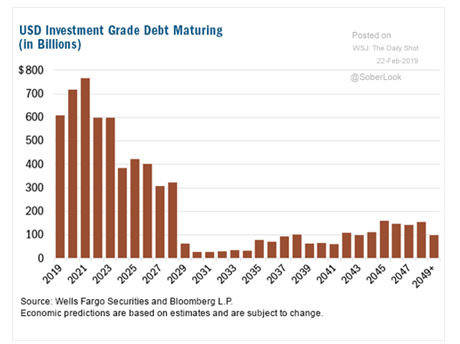
Written by David Haviland
Changes to the Aggregate Bond Index that Advisors Should Know About: Part Two
March 5, 2020 |
Last week, we shared some facts about the Bloomberg Barclays Aggregate Bond Index (BBAB). (Missed it? Click here). Outside of the BBAB, there are a few more items that you may want to know about in the corporate bond landscape that may also surprise you and your clients.
Today, the largest cohort of bonds in the Bloomberg Barclays Investment Grade Index is the lowest level of investment grade (IG) credit, BBB. Back in 2009, the level of BBB bonds in the index was about 32%. Now, BBB credits represent over 50% of the Index. With interest rates so low in recent years, U.S. corporations have taken advantage and issued massive amounts of debt. We’ll get to the amount of debt in a moment, but the point here is that the credit status of half of the investment grade corporate bond universe is in the lowest rating before dropping to junk bond status.

Since the demarcation of Investment Grade versus junk has such a draconian effect on what a corporation pays in interest, there seems to be a reluctance by the rating agencies to downgrade BBB bonds when in fact a junk rating is warranted. Why would this be?
- The rating agencies don’t want to see their customers pay more in interest
- The rating agencies don’t want to be fired
- The rating agencies can’t find enough higher rated debt
- It is a massive undertaking when debt changes to junk status
- All of the above
The answer is E! …but C needs to be fleshed out.
Moral Conflict of Rating Agencies
In my humble opinion, the rating agencies have a moral conflict. To put this moral conflict in perspective, bond issuers, including companies, municipalities, and State and Federal issuers, must pay fees to one or more rating agencies to get rated. These fees are typically assessed annually. Therefore, if a rating agency downgrades an issuer, they stand a much higher chance of being fired or losing that rating fee. So, what tends to happen? Nothing.
Falling from investment grade to junk bond status has dire consequences for the issuer. The cost of borrowing for that company increases dramatically, and their bonds must then be sold by investment grade funds, ETFs, or managers and hopefully bought by junk bond managers. Yet the size of the junk bond market is tiny compared to the investment grade universe, so the prices of these newly rated junk bonds tend to suffer.
You can begin to see why the rating agencies are reluctant to make these downgrades due to the cause and effect on the companies and their profits alike. This leads us to ask: how many companies should be downgraded to junk? On February 28th, Jeff Gundlach of Double Line Investments estimated that 55% of all BBB rated bonds would be rated as junk today if they were “properly” rated.
Investment Grade Debt Maturing
Bonds in general, regardless of rating, have maturity dates. Many investment grade and corporate bonds are issued with relatively short maturities. However, in the aggregate, ~55% of the ~$6 trillion of investment grade debt matures in the next 5 years and ~75% matures in the next ten.

This is important because if interest rates rise even modestly, the renewal rates and increased interest expenses could prove to be a real challenge. Competing with these bonds is the massive $22 trillion of U.S. Treasury debt, an annual federal deficit of $1-1.5 trillion needing treasuries to finance, and even $600 billion of QE reversal. All this supply must be bought by somebody, and the only real question is: at what interest rate?
Click here for Part 1 of this piece on bonds if you missed it!
Sources and Disclosures:
Copyright © 2019 Beaumont Capital Management (BCM). All rights reserved. Past performance is no guarantee of future results.
The Bloomberg Barclays U.S. Aggregate Bond Index provides a measure of the performance of the U.S. dollar denominated investment grade bond market, which includes investment grade government bonds, investment grade corporate bonds, mortgage pass through securities, commercial mortgage backed securities and asset backed securities that are publicly for sale in the United States.
As with all investments, there are associated inherent risks including loss of principal. An investment cannot be made directly in an index.
The views and opinions expressed throughout this presentation are those of our Portfolio Manager as of March 2019. The opinions and outlooks may change over time with changing market conditions or other relevant variables. Although it is believed to be accurate, no representation or warranty is made as to its accuracy or completeness.
This material is for informational purposes only. It is not intended as an offer or solicitation for the purchase or sale of any security or financial instrument, nor should it be construed as financial or investment advice.
The information presented in this report is based on data obtained from third party sources. Although it is believed to be accurate, no representation or warranty is made as to its accuracy or completeness.
Popular Posts
- Financial Sector Breakout, Record Setting Trade Deficits, Underwhelming Regional Fed Reports
- BCM 3Q19 Market Commentary: Blinking Yellow Lights
- BCM 2Q20 Market Commentary: The Best of Times and The Worst of Times…
- Unemployment Plateaus, Good News for Banks, and a Look at Post-Recession EPS Recoveries
- Unemployment Climbs, Strong Recoveries from Retail & Manufacturing, and Trouble for High Yield
